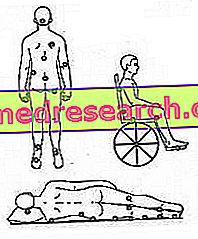Generality
The pelvis, or pelvis, is the inferior part of the trunk of the human body, comprised between the abdomen, superiorly, and the thighs, inferiorly.
Part of the pelvis: the pelvic bones, which form a structure also known as the pelvic girdle; the pelvic cavity, which is the space enclosed by the pelvic girdle; the pelvic floor, which is basically the base of the pelvic cavity; finally, the perineum, which is the anatomical area below the pelvic floor.

The female pelvis has some differences from the male pelvis, especially as regards the arrangement of the pelvic bones and the internal space that these bones create (pelvic cavity). These differences are related to reproduction and to the fact that the female pelvis is the seat of development and growth of the fetus.
The pelvis has three important functions: it supports and, at the same time, unloads on the lower limbs the weight of the upper part of the body; hosts joints and fundamental muscles for locomotion and upright posture; to finish, it contains and protects organs such as the bladder, the urethra, the rectum, the uterus (in the woman), the ovaries (in the woman), the fallopian tubes (in the woman), the prostate (in the man ) etc.
What is the pelvis?
The pelvis, also known as the pelvis or pelvic region, is the lower part of the trunk of the human body, placed between the abdomen (in an upper position) and the thighs (in the lower position) for accuracy.
Anatomy
The pelvis includes:
- The pelvic bones (or pelvic bones );
- The pelvic cavity, space resulting from the particular arrangement of the pelvic bones;
- The pelvic floor, which acts as a base for the pelvic cavity;
- The perineum, located below the pelvic cavity.
BONE OF THE BASIN
The pelvic bones are 4: the sacrum, the two iliac bones and the coccyx .
As they relate to each other, the pelvic bones give rise to an oval-shaped anatomical structure, which experts define with the term pelvic girdle . The pelvic girdle represents the connection between the so-called axile skeleton (composed mainly of skull, thoracic cage and spine) and the skeleton of the lower limbs .
Briefly analyzing the various bones of the pelvis, the sacrum and the coccyx represent the posterior portion of the pelvic girdle as well as the two terminal segments of the vertebral column, in which a vital organ such as the spinal cord houses . The iliac bones, on the other hand, represent the lateral portions and the anterior portion of the pelvic girdle; they constitute to all effects the hips, comprise the articulation of the hips and, joining on the anterior portion of the pelvic girdle, form the so-called pubic symphysis . Subdividable into three regions, known as ilium, ischium and pubis, the iliac bones are connected to the sacrum and from there develop, according to the modalities just mentioned.
From the functional point of view, the bones of the pelvis cover two main tasks: supporting the weight of the upper part of the body and connecting the latter to the lower limbs (specifically to the two femurs, through each hip ).
The function of support, in relation to the upper part of the body, is important especially when the human being stands up, sits, walks, runs etc.
The function of binding to the lower limbs, on the other hand, is indispensable for the purpose of walking.

| Joints of the sacrum: |
|
Joints of each iliac bone: |
|
Joints of coccyx: |
|
PELVIC CAVITY
The pelvic cavity is the body cavity, bounded by the pelvic girdle, anteriorly, posteriorly and laterally, from the pelvic floor, below, and from the so-called pelvic entrance, above.
Between the abdomen and the perineum, the pelvic cavity has a characteristic funnel shape.
Inside the pelvic cavity, large arteries, veins, muscles, nerves and very important organs (the so-called pelvic organs ) take place, including:
- The bladder, located immediately behind the pubic symphysis;
- The rectal intestine, placed approximately in the center of the posterior part of the pelvis, immediately in front of the boundary line between sacrum and coccyx;
- The sigmoid colon (or sigmoid colon ), located to the left of the rectum and communicating with the latter.
- The uterus, the fallopian tubes, the ovaries and the vagina, in the woman;
- The prostate, the vas deferens and the seminal vesicles, in humans.
Most anatomical descriptions of the pelvic cavity show that the latter can be divided into two regions: an upper one, called the large pelvis or false pelvis, and a lower one, called the small pelvis or the true pelvis .
The large pelvis is a space shared with the abdominal cavity ; the small pelvis, on the other hand, is the actual pelvic cavity, which includes the aforementioned organs.
PELVIC FLOOR
Also known as a pelvic diaphragm, the pelvic floor is a rhomboid area, consisting mainly of muscle tissue and to a lesser extent connective tissue, which extends from the pubic symphysis to the coccyx.
The pelvic floor - in particular its muscular tissue - has two important functions: one function is to close the pelvic cavity inferiorly and support the load of the pelvic and abdominal organs; the other function, instead, is to control the openings towards the outside of the rectum and urogenital organs, through appropriate perforations on the muscular tissue and on the connective tissue (the so-called rectal hiatus and urogenital hiatus ).
In essence, therefore, the pelvic floor must guarantee a supporting action, against the bladder, rectum, organs of the reproductive system, etc., and, at the same time, must treat the passage, through its constituent tissues, of those anatomical structures that open outwards.
The pelvic floor muscle tissues belong to two very important muscles, certainly known to most people, which are: the levator ani muscle and the coccygeal muscle .
PERINEUM
In the human being, the perineum is the anatomical area, shaped like a lozenge, corresponding to the lower end of the pelvis.
Underlying the pelvic floor, it follows the extension from the pubic symphysis to the coccyx.
Looking at it from the outside, it is the area of the human body which, in a coccygeal-pubic direction, goes from the anus to the genital organs (vulva, in the woman, and testicles, in man) and which, in the transverse direction, is included between the two thighs.
The perineum includes several muscles (including the external anal sphincter muscle, the urethral sphincter muscle, the bulbospongius muscle, the superficial transverse perineal muscle and the deep transverse perineal muscle), connective tissue, collagen fibers, skin tissue, subcutaneous tissue and ligaments.
According to the most traditional anatomical descriptions, it can be divided into two semi-triangles with the common base: the so-called urogenital triangle, anteriorly, and the so-called anal triangle, posteriorly.
The urogenital triangle contains the genital organs, while the anal triangle encloses the anus .
The junction point of the two triangles - that is, where the base in common resides - coincides with the position occupied by a fibromuscular structure, called the perineal body . The perineal body is a very important anatomical element for at least two reasons:
- It has the task of maintaining the integrity of the pelvic floor, avoiding the prolapse of organs such as the rectum, the bladder, the uterus (in the woman) etc.
- It serves to hook the levator ani muscle (belonging to the aforementioned pelvic floor) and the muscles attributable to the perineum, namely the external anal sphincter muscle, the urethral sphincter muscle, the bulbospongius muscle and the two transverse superficial and deep perineal muscles.
Thanks to the innervation of the so-called pudendal nerve, the perineum represents a erogenous zone, both for the male gender and for the female gender.
DIFFERENCES BETWEEN MAN AND WOMAN
The female pelvis has several differences from the male pelvis. These differences are essentially linked to the reproduction and to the fact that the pelvic cavity of women is used to house the fetus and favor its escape, at the moment of birth.
In the list of differences between female pelvis and male pelvis, we can certainly not miss:
- The presence in the woman of the uterus, fallopian tubes, ovaries and vagina, fundamental organs for the development of the fetus;
- The greater size and breadth of the female pelvis, compared to the male one, which is not only narrower, but also taller and more compact;
- The largest diameter of the female pelvic entrance, compared to the male one;
- The greater thickness and the greater heaviness of the male iliac bones;
- The greater length and narrowness of the male sacrum as well as the presence, in the latter, of a wider sacral promontory (NB: the sacral promontory is the bony prominence which articulates the first sacral vertebra with the last lumbar vertebra);
- The greatest acuity, in humans, of the angle created by the two lower branches of the pubic bones. In the male, the aforementioned angle is approximately 70 °; in the female, instead, it is between 90 and 100 °;
- The greatest distance, in women, between acetabula (NB: the acetabulum is the concavity of the iliac bone that houses the femoral head and forms the hip joint).
If the female pelvis was like the male pelvis (therefore narrower than it really is), the fetus could not grow properly and women, with the advance of pregnancy, would have more and more difficulty walking.
Fortunately, evolution has thought of a solution to these problems.
Functions
The pelvis covers at least 3 relevant functions:
- It supports the weight of the upper part of the body and, at the same time, releases it from the axial skeleton to the skeleton of the lower limbs (which represents a part of the so-called appendicular skeleton );
- It forms joints (eg: hip) and inserts into muscles (eg, some hip muscles), both fundamental for locomotion and maintaining an upright posture;
- It encloses and protects, both through bony structures (the pelvic girdle) and through a solid network of muscles (the so-called abdominals), the so-called pelvic organs (bladder, urethra, rectum, sigma, reproductive organs, etc.).
Hip muscles that relate to the pelvic bones: |
|
|
|
|
|
clinic
From the clinical point of view, the pelvis is very interesting, for at least two reasons: because its bone component is subject, not infrequently, to fractures and because it is the protagonist of a particular painful sensation which, in medical jargon, is called pelvic pain .
BONE FRACTURES
Fractures of the pelvic bones, known more simply as fractures of the pelvis, are injuries of generally traumatic origin, which can also affect more than one bone element.
The typical symptom of pelvic fractures is pain where the fractured bone resides; less frequent but still important symptoms are: lameness (the degree varies according to the severity and location of the fracture), swelling and the presence of hematoma.
Treatment of pelvic fractures depends on the severity of the bone lesion present: for less severe fractures, conservative therapy (or non-surgical therapy) is sufficient, which includes rest until the bone has been welded, the use of aids for the walking and taking painkillers and anticoagulants; for important fractures, on the other hand, surgical therapy is essential, followed by an appropriate period of rest.
CAUSES OF PELVIC PAIN
The possible causes of pelvic pain are numerous, especially among women. For this reason, to simplify consultation, doctors and experts have deemed it appropriate to divide them into at least two broad categories, which correspond to:
- The category of gynecological causes, exclusive of the female sex, e
- The category of non-gynecological causes, of which both men and women can be victims;
Among the gynecological causes of pelvic pain, it is certainly worth mentioning: dysmenorrhea (or painful menstruation), ovulation, endometriosis, rupture of an ovarian cyst, degeneration of a uterine fibroid, episodes of ovarian or tubal torsion, vulvodynia, uterine prolapse, pelvic inflammatory disease, spontaneous abortion, episodes of ectopic pregnancy and rupture of a tube-ovarian abscess.
Among the non-gynecological causes of pelvic pain, on the other hand, we note: episodes of gastroenteritis, inflammatory bowel disease, appendicitis, diverticulitis, tumors of the rectum or sigmoid, constipation, intestinal obstruction, perirectal abscess, irritable bowel syndrome, diseases of the urinary tract (such as cystitis, pyelonephritis, urolithiasis and tumors), episodes of intestinal perforation and stretching of the abdominal muscles that contain the organs of the pelvis.



